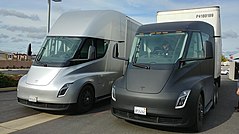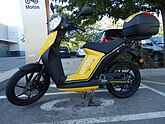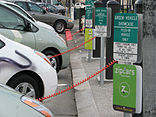Electric vehicle
| |||||
Electric vehicles around the world (from top left):
|
An electric vehicle (EV)[note 1] is a vehicle that uses one or more electric motors for propulsion. It can be powered by a collector system, with electricity from extravehicular sources, or it can be powered autonomously by a battery (sometimes charged by solar panels, or by converting fuel to electricity using fuel cells or a generator).[1] EVs include, but are not limited to, road and rail vehicles, surface and underwater vessels, electric aircraft and electric spacecraft.
EVs first came into existence in the mid-19th century, when electricity was among the preferred methods for motor vehicle propulsion, providing a level of comfort and ease of operation that could not be achieved by the gasoline cars of the time. Internal combustion engines were the dominant propulsion method for cars and trucks for about 100 years, but electric power remained commonplace in other vehicle types, such as trains and smaller vehicles of all types.
In the 21st century, EVs have seen a resurgence due to technological developments, and an increased focus on renewable energy and the potential reduction of transportation's impact on climate change and other environmental issues. Project Drawdown describes electric vehicles as one of the 100 best contemporary solutions for addressing climate change.[2]
Government incentives to increase adoption were first introduced in the late 2000s, including in the United States and the European Union, leading to a growing market for the vehicles in the 2010s.[3][4] Increasing public interest and awareness and structural incentives, such as those being built into the green recovery from the COVID-19 pandemic, is expected to greatly increase the electric vehicle market. The International Energy Agency said in 2021 that governments should do more to meet climate goals, including policies for heavy electric vehicles.[5] Electric vehicle sales may increase from 2% of global share in 2016 to 30% by 2030.[6][7][8] Much of this growth is expected in markets like North America, Europe and China;[7] a 2020 literature review suggested that growth in use of electric 4-wheeled vehicles appears economically unlikely in developing economies, but that electric 2-wheeler growth is likely.[9] There are more 2 and 3 wheel EVs than any other type.[10]
History[]
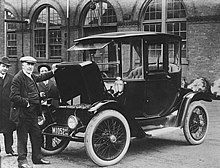
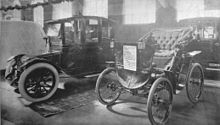
Electric motive power started in 1827, when Hungarian priest Ányos Jedlik built the first crude but viable electric motor, provided with stator, rotor and commutator; the next year, he used it to power a tiny car.[11] In 1835, professor Sibrandus Stratingh of the University of Groningen, the Netherlands, built a small-scale electric car, and between 1832 and 1839 (the exact year is uncertain), Robert Anderson of Scotland invented the first crude electric carriage, powered by non-rechargeable primary cells.[12] American blacksmith and inventor Thomas Davenport built a toy electric locomotive, powered by a primitive electric motor, in 1835. In 1838, a Scotsman named Robert Davidson built an electric locomotive that attained a speed of four miles per hour (6 km/h). In England a patent was granted in 1840 for the use of rails as conductors of electric current, and similar American patents were issued to Lilley and Colten in 1847.[13]
The first mass-produced electric vehicles appeared in America in the early 1900s. In 1902, the Studebaker Automobile Company entered the automotive business with electric vehicles, though it also entered the gasoline vehicles market in 1904. However, with the advent of cheap assembly line cars by Ford, the popularity of electric cars declined significantly.[14]
Due to the limitations of storage batteries at that time, electric cars did not gain much popularity; however, electric trains gained immense popularity due to their economies and achievable speeds. By the 20th century, electric rail transport became commonplace due to advances in the development of electric locomotives. Over time their general-purpose commercial use reduced to specialist roles as platform trucks, forklift trucks, ambulances,[15] tow tractors and urban delivery vehicles, such as the iconic British milk float; for most of the 20th century, the UK was the world's largest user of electric road vehicles.[16]
Electrified trains were used for coal transport, as the motors did not use precious oxygen in the mines. Switzerland's lack of natural fossil resources forced the rapid electrification of their rail network. One of the earliest rechargeable batteries – the nickel-iron battery – was favored by Edison for use in electric cars.
EVs were among the earliest automobiles, and before the preeminence of light, powerful internal combustion engines, electric automobiles held many vehicle land speed and distance records in the early 1900s. They were produced by Baker Electric, Columbia Electric, Detroit Electric, and others, and at one point in history out-sold gasoline-powered vehicles. In 1900, 28 percent of the cars on the road in the US were electric. EVs were so popular that even President Woodrow Wilson and his secret service agents toured Washington, D.C. in their Milburn Electrics, which covered 60–70 mi (100–110 km) per charge.[17]
A number of developments contributed to a decline in the popularity of electric cars.[18] Improved road infrastructure required a greater range than that offered by electric cars, and the discovery of large reserves of petroleum in Texas, Oklahoma, and California led to the wide availability of affordable gasoline/petrol, making internal combustion powered cars cheaper to operate over long distances.[19] Also, internal combustion powered cars became ever-easier to operate thanks to the invention of the electric starter by Charles Kettering in 1912,[20] which eliminated the need of a hand crank for starting a gasoline engine, and the noise emitted by ICE cars became more bearable thanks to the use of the muffler, which Hiram Percy Maxim had invented in 1897. As roads were improved outside urban areas, electric vehicle range could not compete with the ICE. Finally, the initiation of mass production of gasoline-powered vehicles by Henry Ford in 1913 reduced significantly the cost of gasoline cars as compared to electric cars.[21]
In the 1930s, National City Lines, which was a partnership of General Motors, Firestone, and Standard Oil of California purchased many electric tram networks across the country to dismantle them and replace them with GM buses. The partnership was convicted of conspiring to monopolize the sale of equipment and supplies to their subsidiary companies, but were acquitted of conspiring to monopolize the provision of transportation services.
Experimentation[]

The emergence of metal–oxide–semiconductor (MOS) technology led to the development of modern electric road vehicles.[22] The MOSFET (MOS field-effect transistor, or MOS transistor), invented by Mohamed M. Atalla and Dawon Kahng at Bell Labs in 1959,[23][24] led to the development of the power MOSFET by Hitachi in 1969,[25] and the single-chip microprocessor by Federico Faggin, Marcian Hoff, Masatoshi Shima and Stanley Mazor at Intel in 1971.[26] The power MOSFET and the microcontroller, a type of single-chip microprocessor, led to significant advances in electric vehicle technology. MOSFET power converters allowed operation at much higher switching frequencies, made it easier to drive, reduced power losses, and significantly reduced prices, while single-chip microcontrollers could manage all aspects of the drive control and had the capacity for battery management. Insulated-gate bipolar transistor (IGBT) technology made possible the use of the synchronous AC three phase motor, by creating a synthetic three phase alternating current from, for example, a DC traction battery pack. This technique was developed by Hughes and GM and used in their US Electricar in 1995, but still used the heavy (26 count 12 Volt) lead acid, series connected batteries. GM later developed an electric pickup truck and then the EV1. This motor and controller was kept alive and used in converted cars by AC Propulsion, where they introduced the lithium battery that Elon Musk later saw and embraced.[22] Another important technology that enabled modern highway-capable electric cars is the lithium-ion battery,[27] invented by John Goodenough, Rachid Yazami and Akira Yoshino in the 1980s,[28] which was responsible for the development of electric vehicles capable of long-distance travel.[27]
In January 1990, General Motors' President introduced its EV concept two-seater, the "Impact", at the Los Angeles Auto Show. That September, the California Air Resources Board mandated major-automaker sales of EVs, in phases starting in 1998. From 1996 to 1998 GM produced 1117 EV1s, 800 of which were made available through three-year leases.[29]
Chrysler, Ford, GM, Honda, and Toyota also produced limited numbers of EVs for California drivers. In 2003, upon the expiration of GM's EV1 leases, GM discontinued them. The discontinuation has variously been attributed to:
- the auto industry's successful federal court challenge to California's zero-emissions vehicle mandate,
- a federal regulation requiring GM to produce and maintain spare parts for the few thousands EV1s and
- the success of the oil and auto industries' media campaign to reduce public acceptance of EVs.

A movie made on the subject in 2005–2006 was titled Who Killed the Electric Car? and released theatrically by Sony Pictures Classics in 2006. The film explores the roles of automobile manufacturers, oil industry, the U.S. government, batteries, hydrogen vehicles, and the general public, and each of their roles in limiting the deployment and adoption of this technology.
Ford released a number of their Ford Ecostar delivery vans into the market. Honda, Nissan and Toyota also repossessed and crushed most of their EVs, which, like the GM EV1s, had been available only by closed-end lease. After public protests, Toyota sold 200 of its RAV4 EVs; they later sold at over their original forty-thousand-dollar price. Later, BMW of Canada sold off a number of Mini EVs when their Canadian testing ended.
The production of the Citroën Berlingo Electrique stopped in September 2005.
Reintroduction[]
| A subtopic of sustainability |
| Sustainable transport |
|---|
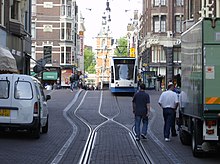 |
| Also relevant to: |
|
| Aspects of sustainable transport: |
|
| Sustainable transport toolbox |
|
|

During the late 20th and early 21st century, the environmental impact of the petroleum-based transportation infrastructure, along with the fear of peak oil, led to renewed interest in an electric transportation infrastructure.[30] EVs differ from fossil fuel-powered vehicles in that the electricity they consume can be generated from a wide range of sources, including fossil fuels, nuclear power, and renewables such solar power and wind power or any combination of those. The carbon footprint and other emissions of electric vehicles varies depending on the fuel and technology used for electricity generation.[31][32] The electricity may be stored in the vehicle using a battery, flywheel, or supercapacitors. Vehicles using internal combustion engines usually only derive their energy from a single or a few sources, usually non-renewable fossil fuels. A key advantage of electric vehicles is regenerative braking, which recovers kinetic energy, typically lost during friction braking as heat, as electricity restored to the on-board battery.
Electricity sources[]
There are many ways to generate electricity, of varying costs, efficiency and ecological desirability.


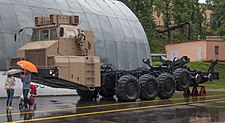
Connection to generator plants[]
- Direct connection to generation plants as is common among electric trains, trams, trolleybuses, and trolleytrucks (See also: overhead lines, third rail and conduit current collection)
- Online electric vehicle collect power from electric power strips buried under the road surface through electromagnetic induction
Onboard generators and hybrid EVs[]
- Generated on-board using a diesel engine: diesel–electric locomotive and diesel–electric multiple unit (DEMU)
- Generated on-board using a fuel cell: fuel cell vehicle
- Generated on-board using nuclear energy: nuclear submarines and aircraft carriers
- Renewable sources such as solar power: solar vehicle
It is also possible to have hybrid EVs that derive electricity from multiple sources, such as:
- On-board rechargeable electricity storage system (RESS) and a direct continuous connection to land-based generation plants for purposes of on-highway recharging with unrestricted highway range[33]
- On-board rechargeable electricity storage system and a fueled propulsion power source (internal combustion engine): plug-in hybrid
For especially large EVs, such as submarines, the chemical energy of the diesel–electric can be replaced by a nuclear reactor. The nuclear reactor usually provides heat, which drives a steam turbine, which drives a generator, which is then fed to the propulsion. See Nuclear marine propulsion.
A few experimental vehicles, such as some cars and a handful of aircraft use solar panels for electricity.
Onboard storage[]
| Vehicle type | Fuel used |
|---|---|
| All-petroleum vehicle | Most use of petroleum |
| Regular hybrid electric vehicle |
Less use of petroleum, but unable to be plugged in |
| Plug-in hybrid vehicle | Less use of petroleum, residual use of electricity |
| All-electric vehicle (BEV, AEV) |
Exclusively uses electricity |
These systems are powered from an external generator plant (nearly always when stationary), and then disconnected before motion occurs, and the electricity is stored in the vehicle until needed.
- Full Electric Vehicles (FEV).[34] Power storage methods include:
- Chemical energy stored on the vehicle in on-board batteries: Battery electric vehicle (BEV) typically with a lithium-ion battery
- Kinetic energy storage: flywheels
- Static energy stored on the vehicle in on-board electric double-layer capacitors
Batteries, electric double-layer capacitors and flywheel energy storage are forms of rechargeable on-board electricity storage systems. By avoiding an intermediate mechanical step, the energy conversion efficiency can be improved compared to hybrids by avoiding unnecessary energy conversions. Furthermore, electro-chemical batteries conversions are easy to reverse, allowing electrical energy to be stored in chemical form.[citation needed]
Lithium-ion battery[]
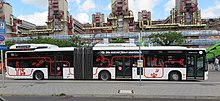

Most electric vehicles use lithium-ion batteries (Li-Ions or LIBs). Lithium ion batteries have higher energy density, longer life span and higher power density than most other practical batteries. Complicating factors include safety, durability, thermal breakdown and cost. Li-ion batteries should be used within safe temperature and voltage ranges in order to operate safely and efficiently.[35]
Increasing the battery's lifespan decreases effective costs. One technique is to operate a subset of the battery cells at a time and switching these subsets.[36]
In the past, nickel–metal hydride battery batteries were used in some electric cars, such as those made by General Motors.[37] These battery types are considered outdated due to their tendencies to self-discharge in the heat.[38] Furthermore, a patent for this type of battery was held by Chevron, which created a problem for their widespread development.[39] These factors, coupled with their high cost, has led to lithium-ion batteries leading as the predominant battery for EVs.[40]
The prices of lithium-ion batteries are constantly decreasing, contributing to a reduction in price for electric vehicles.[41]
Electric motor[]
The power of a vehicle's electric motor, as in other machines, is measured in kilowatts (kW). Electric motors can deliver their maximum torque over a wide RPM range. This means that the performance of a vehicle with a 100 kW electric motor exceeds that of a vehicle with a 100 kW internal combustion engine, which can only deliver its maximum torque within a limited range of engine speed.
Efficiency of charging varies considerably depending on the type of charger,[42] and energy is lost during the process of converting the electrical energy to mechanical energy.
Usually, direct current (DC) electricity is fed into a DC/AC inverter where it is converted to alternating current (AC) electricity and this AC electricity is connected to a 3-phase AC motor.
For electric trains, forklift trucks, and some electric cars, DC motors are often used. In some cases, universal motors are used, and then AC or DC may be employed. In recent production vehicles, various motor types have been implemented; for instance, induction motors within Tesla Motor vehicles and permanent magnet machines in the Nissan Leaf and Chevrolet Bolt.[43]
Vehicle types[]
It is generally possible to equip any kind of vehicle with an electric power-train.
Ground vehicles[]
Pure-electric vehicles[]
A pure-electric vehicle or all-electric vehicle is powered exclusively through electric motors. The electricity may come from a battery (battery electric vehicle), solar panel (solar vehicle) or fuel cell (fuel cell vehicle).
Hybrid EVs[]
A hybrid electric vehicle (HEV) is a type of hybrid vehicle that combines a conventional internal combustion engine (ICE) system with an electric propulsion system (hybrid vehicle drivetrain). The presence of the electric powertrain is intended to achieve either better fuel economy than a conventional vehicle or better performance. There is a variety of HEV types and the degree to which each function as an electric vehicle (EV) also varies. The most common form of HEV is the hybrid electric car, although hybrid electric trucks (pickups and tractors), buses, boats and aircraft also exist.
Modern HEVs make use of efficiency-improving technologies such as regenerative brakes which convert the vehicle's kinetic energy to electric energy, which is stored in a battery or supercapacitor. Some varieties of HEV use an internal combustion engine to turn an electrical generator, which either recharges the vehicle's batteries or directly powers its electric drive motors; this combination is known as a motor–generator. Many HEVs reduce idle emissions by shutting down the engine at idle and restarting it when needed; this is known as a start-stop system. A hybrid-electric produces fewer tailpipe emissions than a comparably sized gasoline car since the hybrid's gasoline engine is usually smaller than that of a gasoline-powered vehicle. If the engine is not used to drive the car directly, it can be geared to run at maximum efficiency, further improving fuel economy.Plug-in electric vehicle[]
A plug-in electric vehicle (PEV) is any motor vehicle that can be recharged from any external source of electricity, such as wall sockets, and the electricity stored in the Rechargeable battery packs drives or contributes to drive the wheels. PEV is a subcategory of electric vehicles that includes battery electric vehicles (BEVs), plug-in hybrid vehicles, (PHEVs), and electric vehicle conversions of hybrid electric vehicles and conventional internal combustion engine vehicles.[44][45][46]
Range-extended electric vehicle[]
A range-extended electric vehicle (REEV) is a vehicle powered by an electric motor and a plug-in battery. An auxiliary combustion engine is used only to supplement battery charging and not as the primary source of power.[47]
On- and off-road EVs[]

On-road electric vehicles include electric cars, electric trolleybuses, electric buses, battery electric buses, electric trucks, electric bicycles, electric motorcycles and scooters, personal transporters, neighborhood electric vehicles, golf carts, milk floats, and forklifts. Off-road vehicles include electrified all-terrain vehicles and tractors.
Railborne EVs[]

The fixed nature of a rail line makes it relatively easy to power EVs through permanent overhead lines or electrified third rails, eliminating the need for heavy onboard batteries. Electric locomotives, electric multiple units, electric trams (also called streetcars or trolleys), electric light rail systems, and electric rapid transit are all in common use today, especially in Europe and Asia.
Since electric trains do not need to carry a heavy internal combustion engine or large batteries, they can have very good power-to-weight ratios. This allows high speed trains such as France's double-deck TGVs to operate at speeds of 320 km/h (200 mph) or higher, and electric locomotives to have a much higher power output than diesel locomotives. In addition, they have higher short-term surge power for fast acceleration, and using regenerative brakes can put braking power back into the electrical grid rather than wasting it.
Maglev trains are also nearly always EVs.[49]
There are also battery electric passenger trains operating on non-electrified rail lines.
Space rover vehicles[]
Manned and unmanned vehicles have been used to explore the Moon and other planets in the solar system. On the last three missions of the Apollo program in 1971 and 1972, astronauts drove silver-oxide battery-powered Lunar Roving Vehicles distances up to 35.7 kilometers (22.2 mi) on the lunar surface.[50] Unmanned, solar-powered rovers have explored the Moon and Mars.[51][52]
Airborne EVs[]
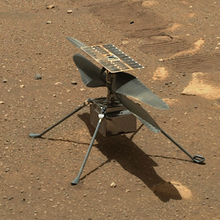
Since the beginnings of aviation, electric power for aircraft has received a great deal of experimentation. Currently, flying electric aircraft include manned and unmanned aerial vehicles.
Seaborne EVs[]

Electric boats were popular around the turn of the 20th century. Interest in quiet and potentially renewable marine transportation has steadily increased since the late 20th century, as solar cells have given motorboats the infinite range of sailboats. Electric motors can and have also been used in sailboats instead of traditional diesel engines.[53] Electric ferries operate routinely.[54] Submarines use batteries (charged by diesel or gasoline engines at the surface), nuclear power, fuel cells[55] or Stirling engines to run electric motor-driven propellers.
Electrically powered spacecraft[]
Electric power has a long history of use in spacecraft.[56][57] The power sources used for spacecraft are batteries, solar panels and nuclear power. Current methods of propelling a spacecraft with electricity include the arcjet rocket, the electrostatic ion thruster, the Hall effect thruster, and Field Emission Electric Propulsion.
Energy and motors[]
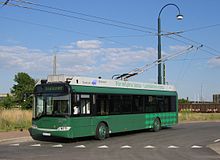

Most large electric transport systems are powered by stationary sources of electricity that are directly connected to the vehicles through wires. Electric traction allows the use of regenerative braking, in which the motors are used as brakes and become generators that transform the motion of, usually, a train into electrical power that is then fed back into the lines. This system is particularly advantageous in mountainous operations, as descending vehicles can produce a large portion of the power required for those ascending. This regenerative system is only viable if the system is large enough to utilise the power generated by descending vehicles.
In the systems above, motion is provided by a rotary electric motor. However, it is possible to "unroll" the motor to drive directly against a special matched track. These linear motors are used in maglev trains which float above the rails supported by magnetic levitation. This allows for almost no rolling resistance of the vehicle and no mechanical wear and tear of the train or track. In addition to the high-performance control systems needed, switching and curving of the tracks becomes difficult with linear motors, which to date has restricted their operations to high-speed point to point services.
Properties[]
Components[]
The type of battery, the type of traction motor and the motor controller design vary according to the size, power and proposed application, which can be as small as a motorized shopping cart or wheelchair, through pedelecs, electric motorcycles and scooters, neighborhood electric vehicles, industrial fork-lift trucks and including many hybrid vehicles.
Energy sources[]
EVs are much more efficient than fossil fuel vehicles and have few direct emissions. At the same time, they do rely on electrical energy that is generally provided by a combination of non-fossil fuel plants and fossil fuel plants. Consequently, EVs can be made less polluting overall by modifying the source of electricity. In some areas, persons can ask utilities to provide their electricity from renewable energy.
Fossil fuel vehicle efficiency and pollution standards take years to filter through a nation's fleet of vehicles. New efficiency and pollution standards rely on the purchase of new vehicles, often as the current vehicles already on the road reach their end-of-life. Only a few nations set a retirement age for old vehicles, such as Japan or Singapore, forcing periodic upgrading of all vehicles already on the road.
Batteries[]
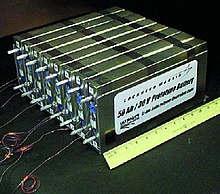
An electric-vehicle battery (EVB) in addition to the traction battery speciality systems used for industrial (or recreational) vehicles, are batteries used to power the propulsion system of a battery electric vehicle (BEVs). These batteries are usually a secondary (rechargeable) battery, and are typically lithium-ion batteries. Traction batteries, specifically designed with a high ampere-hour capacity, are used in forklifts, electric golf carts, riding floor scrubbers, electric motorcycles, electric cars, trucks, vans, and other electric vehicles.[citation needed]
Efficiency[]
EVs convert over 59-62% of grid energy to the wheels. Conventional gasoline vehicles convert only some 17%–21%.[58]
Charging[]
Grid capacity[]
If almost all road vehicles were electric it would increase global demand for electricity by up to 25% by 2050 compared to 2020.[59] However, overall energy consumption and emissions would diminish because of the higher efficiency of EVs over the entire cycle.
Charging stations[]
| ||||
Charging stations for electric vehicles:
|
A charging station, also called an EV charger or electric vehicle supply equipment (EVSE), is a piece of equipment that supplies electrical power for charging plug-in electric vehicles (including hybrids, neighborhood electric vehicles, trucks, buses, and others).
Although batteries can only be charged with DC power, most electric vehicles have an onboard AC-to-DC converter that allows them to be plugged into a standard household AC electrical receptacle. Inexpensive low-power public charging stations will also provide AC power, known as "AC charging stations". To facilitate higher power charging, which requires much larger AC-to-DC converters, the converter is built into the charging station instead of the vehicle, and the station supplies already-converted DC power directly to the vehicle, bypassing the vehicle's onboard converter. These are known as "DC charging stations". Most fully electric car models can accept both AC and DC power.
Charging stations provide connectors that conform to a variety of standards. DC charging stations are commonly equipped with multiple connectors to be able to supply a wide variety of vehicles.
Public charging stations are typically found street-side or at retail shopping centers, government facilities, and other parking areas.Battery swapping[]
Instead of recharging EVs from electric socket, batteries could be mechanically replaced at special stations in a few minutes (battery swapping).
Batteries with greatest energy density such as metal-air fuel cells usually cannot be recharged in purely electric way. Instead, some kind of metallurgical process is needed, such as aluminum smelting and similar.
Dynamic charging[]
| Type(developer) | Power | Million SEKper km road | References |
|---|---|---|---|
| Overhead powerlines (Siemens) | 650 kW | 12.4 | [60]:140–144[61]:23–24,54 |
| Ground-level power supply through in-roadrail (Elways) | 200 kW | 9.4-10.5 | [60]:146–149[61]:21–23,54 |
| Ground-level powersupply through on-road rail ( and ABB) | 300 kW | 11.5-15.3 | [61]:25–26,54 |
| Ground-level powersupply through in-roadinductive coils (Electreon) | 25 kW | 19.5-20.8 | [60]:171–172[61]:26–28,54 |
Dynamic charging allows electric vehicles to charge while driving on roads or highways. Sweden is scheduled to complete testing of four different dynamic charging technologies by 2022.[61]
ABB announced in 2021 that it is involved in the construction of the first permanent electric road that powers private vehicles and commercial vehicles such as trucks and buses, using ground-level power supply technology.[62][63] The European Commission published in 2021 a request for regulation and standardization of electric road systems.[64] Alstom and other companies have, in 2020, begun drafting a standard for ground-level power supply electric roads.[65]
Other in-development technologies[]
This section needs expansion with: up-to-date information. You can help by . (July 2021) |
Conventional electric double-layer capacitors are being worked on to achieve the energy density of lithium-ion batteries, offering almost unlimited lifespans and no environmental issues. High-K electric double-layer capacitors, such as EEStor's EESU, could improve lithium ion energy density several times over if they can be produced. Lithium-sulphur batteries offer 250 Wh/kg.[66] Sodium-ion batteries promise 400 Wh/kg with only minimal expansion/contraction during charge/discharge and a very high surface area.[67]
Safety[]
This section needs expansion with: up-to-date information. You can help by . (July 2021) |
The United Nations in Geneva (UNECE) has adopted the first international regulation (Regulation 100) on safety of both fully electric and hybrid electric cars, with the intent of ensuring that cars with a high voltage electric power train, such as hybrid and fully-electric vehicles, are as safe as combustion-powered cars. The EU and Japan have already indicated that they intend to incorporate the new UNECE Regulation in their respective rules on technical standards for vehicles.[68]
Environmental[]
EVs release no tailpipe air pollutants; however, EVs are charged with electricity that may be generated by means that have health and environmental impacts, and the air emissions associated with manufacturing an electric vehicle can be greater than those of manufacturing a conventional vehicle.[69][70][better source needed]
The carbon emissions from producing and operating an EV are typically less than those of producing and operating a conventional vehicle.[71] EVs in urban areas almost always pollute less than internal combustion vehicles.[72]
One limitation of the environmental potential of EVs is that simply switching the existing privately owned car fleet from ICEs to EVs will not free up road space for active travel or public transport.[73] Electric micromobility vehicles, such as e-bikes, may contribute to the decarbonisation of transport systems, especially outside of urban areas which are already well-served by public transport.[74]
Internal combustion engined vehicles use far more raw materials over their lifetime than EVs.[75]
Since their first commercial release in 1991, lithium-ion batteries have become an important technology for achieving low-carbon transportation systems. The sustainability of production process of batteries has not been fully assessed in either economic, social or environmental terms.[76]
The resources are considered to be owned by the society at large.[citation needed] However, business processes of raw material extraction in practice raise issues of transparency and accountability of the management of extractive resources. In the complex supply chain of lithium technology, there are diverse stakeholders representing corporate interests, public interest groups and political elites that are concerned with outcomes from the technology production and use. One possibility to achieve balanced extractive processes would be the establishment of commonly agreed standards on the governance of technology worldwide.[76]
The compliance of these standards can be assessed by the Assessment of Sustainability in Supply Chains Frameworks (ASSC). Hereby, the qualitative assessment consists of examining governance and social and environmental commitment. Indicators for the quantitative assessment are management systems and standards, compliance and social and environmental indicators.[77]
Socio-economic[]
Pollution from fossil fuel vehicles affects poorer people more.[78]
Mechanical[]
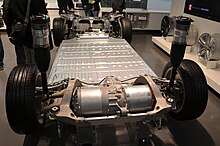
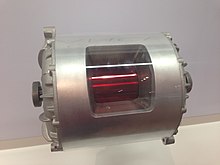
Electric motors are mechanically very simple and often achieve 90% energy conversion efficiency[79] over the full range of speeds and power output and can be precisely controlled. They can also be combined with regenerative braking systems that have the ability to convert movement energy back into stored electricity. This can be used to reduce the wear on brake systems (and consequent brake pad dust) and reduce the total energy requirement of a trip. Regenerative braking is especially effective for start-and-stop city use.
They can be finely controlled and provide high torque from stationary-to-moving, unlike internal combustion engines, and do not need multiple gears to match power curves. This removes the need for gearboxes and torque converters.
EVs provide quiet and smooth operation and consequently have less noise and vibration than internal combustion engines.[80] While this is a desirable attribute, it has also evoked concern that the absence of the usual sounds of an approaching vehicle poses a danger to blind, elderly and very young pedestrians. To mitigate this situation, many countries mandate warning sounds when EVs are moving slowly, up to a speed when normal motion and rotation (road, suspension, electric motor, etc.) noises become audible.[81]
Electric motors do not require oxygen, unlike internal combustion engines; this is useful for submarines and for space rovers.
Energy resilience[]
Electricity can be produced from a variety of sources; therefore, it gives the greatest degree of energy resilience.[82]
Energy efficiency[]
EV 'tank-to-wheels' efficiency is about a factor of three higher than internal combustion engine vehicles.[80] Energy is not consumed while the vehicle is stationary, unlike internal combustion engines which consume fuel while idling. However, looking at the well-to-wheel efficiency of EVs, their total emissions, while still lower, are closer to an efficient gasoline or diesel in most countries where electricity generation relies on fossil fuels.[83][84]
Well-to-wheel efficiency of an EV has less to do with the vehicle itself and more to do with the method of electricity production. A particular EV would instantly become twice as efficient if electricity production were switched from fossil fuels to renewable energy, such as wind power, tidal power, solar power, and nuclear power. Thus, when "well-to-wheels" is cited, the discussion is no longer about the vehicle, but rather about the entire energy supply infrastructure – in the case of fossil fuels this should also include energy spent on exploration, mining, refining, and distribution.
The lifecycle analysis of EVs shows that even when powered by the most carbon-intensive electricity in Europe, they emit less greenhouse gases than a conventional diesel vehicle.[85]
Total cost[]
As of 2021 the purchase price of a EV is often more, but the total cost of ownership of an EV varies wildly depending on location[86] and distance travelled per year:[87] in parts of the world where fossil fuels are subsidized, lifecycle costs of diesel or gas-powered vehicle are sometimes less than a comparable EV.[88]
Stabilization of the grid[]
Since EVs can be plugged into the electric grid when not in use, there is a potential for battery-powered vehicles to cut the demand for electricity by feeding electricity into the grid from their batteries during peak use periods (such as mid-afternoon air conditioning use) while doing most of their charging at night, when there is unused generating capacity.[89][90] This vehicle-to-grid (V2G) connection has the potential to reduce the need for new power plants, as long as vehicle owners do not mind reducing the life of their batteries, by being drained by the power company during peak demand. Electric vehicle parking lots can provide demand response.[91]
Furthermore, current electricity infrastructure may need to cope with increasing shares of variable-output power sources such as wind and solar. This variability could be addressed by adjusting the speed at which EV batteries are charged, or possibly even discharged.
Some concepts see battery exchanges and battery charging stations, much like gas/petrol stations today. These will require enormous storage and charging potentials, which could be manipulated to vary the rate of charging, and to output power during shortage periods, much as diesel generators are used for short periods to stabilize some national grids.[92][93]
Range[]
Electric vehicles may have shorter range compared to vehicles with internal combustion engines, [94][95] which is why large electric ships generally cannot cross oceans as of 2021.[96]
Heating of EVs[]
In cold climates, considerable energy is needed to heat the interior of a vehicle and to defrost the windows. With internal combustion engines, this heat already exists as waste combustion heat diverted from the engine cooling circuit. This process offsets the greenhouse gases' external costs. If this is done with battery EVs, the interior heating requires extra energy from the vehicles' batteries. Although some heat could be harvested from the motor or motors and battery, their greater efficiency means there is not as much waste heat available as from a combustion engine.
However, for vehicles which are connected to the grid, battery EVs can be preheated, or cooled, with little or no need for battery energy, especially for short trips.
Newer designs are focused on using super-insulated cabins which can heat the vehicle using the body heat of the passengers. This is not enough, however, in colder climates as a driver delivers only about 100 W of heating power. A heat pump system, capable of cooling the cabin during summer and heating it during winter, is a more efficient way of heating and cooling EVs.[97]
Electric public transit efficiency[]
Shifts from private to public transport (train, trolleybus, personal rapid transit or tram) have the potential for large gains in efficiency in terms of an individual's distance traveled per kWH.
Research shows people prefer trams to buses,[98] because they are quieter and more comfortable and perceived as having higher status.[99] Therefore, it may be possible to cut liquid fossil fuel consumption in cities through the use of electric trams. Trams may be the most energy-efficient form of public transportation, with rubber-wheeled vehicles using two-thirds more energy than the equivalent tram,[citation needed] and run on electricity rather than fossil fuels.
In terms of net present value, they are also the cheapest – Blackpool trams are still running after 100 years,[100] but combustion buses only last about 15 years.
Polluter pays principle[]
The IEA says that gasoline and diesel should be taxed according to the damage they do to health and the environment.[5] Government procurement is sometimes used to encourage national EV manufacturers.[101][102] Many countries will ban sales of fossil fuel vehicles between 2025 and 2040.[103]
Many governments offer incentives to promote the use of electric vehicles, with the goals of reducing air pollution and oil consumption. Some incentives intend to increase purchases of electric vehicles by offsetting the purchase price with a grant. Other incentives include lower tax rates or exemption from certain taxes, and investment in charging infrastructure.
Companies selling EVs have partnered with local electric utilities in order to provide large incentives on some electric vehicles.[104]
Future[]

In 2008, Ferdinand Dudenhoeffer, head of the Centre of Automotive Research at the Gelsenkirchen University of Applied Sciences in Germany, predicted that "by 2025, all passenger cars sold in Europe will be electric or hybrid electric".[105] The COVID-19 pandemic gave birth to proposals for radical change in the organisation of the city, such as the Manifesto for the Reorganisation of the City after COVID19, published in Barcelona and signed by 160 academics and 300 architects, highly critical towards a transportation based on the private electric vehicle considered as a false solution.[106][107][108]
Environmental considerations[]
Despite one of the goals of electric vehicle adoption being to limit the carbon footprint and pollution caused by internal combustion engine vehicles, a rising concern amongst environmentalists is the manufacturing process of electric vehicle batteries.[citation needed] In current practice, these vehicle batteries rely heavily on the mining industry of rare earth metals such as cobalt, nickel, and copper.[109][110] According to 2018 study the supplies of mined metals would need to increase 87'000% by 2060 globally for transition to battery-powered EVs. Rare-earth metals (neodymium, dysprosium) and other mined metals (copper, nickel, iron) are used by EV motors, while lithium, cobalt, manganese are used by the batteries. [111][110]
An alternative method of sourcing essential battery materials being deliberated by the International Seabed Authority is deep sea mining of these metals.[112]
Improved batteries[]
Advances in lithium-ion batteries, driven at first by the personal-use electronics industry, allow full-sized, highway-capable EVs to travel nearly as far on a single charge as conventional cars go on a single tank of gasoline. Lithium batteries have been made safe, can be recharged in minutes instead of hours (see recharging time), and now last longer than the typical vehicle (see lifespan). The production cost of these lighter, higher-capacity lithium-ion batteries is gradually decreasing as the technology matures and production volumes increase.[113][114]
Many companies and researchers are also working on newer battery technologies, including solid state batteries[115] and alternate technologies.[116]
Battery management and intermediate storage[]
Another improvement is to decouple the electric motor from the battery through electronic control, using supercapacitors to buffer large but short power demands and regenerative braking energy.[117] The development of new cell types combined with intelligent cell management improved both weak points mentioned above. The cell management involves not only monitoring the health of the cells but also a redundant cell configuration (one more cell than needed). With sophisticated switched wiring, it is possible to condition one cell while the rest are on duty.[citation needed]
Electric trucks[]

An electric truck is an electric vehicle powered by batteries designed to transport cargo, carry specialized payloads, or perform other utilitarian work.
Electric trucks have serviced niche applications like milk floats, pushback tugs and forklifts for over a hundred years, typically using lead-acid batteries, but the rapid development of lighter and more energy-dense battery chemistries in the twenty-first century has broadened the range of applicability of electric propulsion to trucks in many more roles.
Electric trucks reduce noise and pollution, relative to internal-combustion trucks. Due to the high efficiency and low component-counts of electric power trains, the costs of owning and operating electric trucks are dramatically lower than their predecessors.[118][119] According to the United States Department of Energy, the average cost per kWh capacity of battery packs for trucks fell from $500 in 2013 to $200 in 2019, and still further to $137 in 2020, with some vehicles under $100 for the first time.[120][121]
Long-distance freight has been the trucking segment least amenable to electrification, since the increased weight of batteries, relative to fuel, detracts from payload capacity, and the alternative, more frequent recharging, detracts from delivery time. By contrast, short-haul urban delivery has been electrified rapidly, since the clean and quiet nature of electric trucks fit well with urban planning and municipal regulation, and the capacities of reasonably-sized batteries are well-suited to daily stop-and-go traffic within a metropolitan area.[122][123][124]
In South Korea, electric trucks hold a noticeable share of the new truck market; in 2020, among trucks produced and sold domestically (which are the vast majority of new trucks sold in the country), 7.6% were all-electric vehicles.[125]Hydrogen trains[]
Particularly in Europe, fuel-cell electric trains are gaining in popularity to replace diesel-electric units. In Germany, several Länder have ordered Alstom Coradia iLINT trainsets, in service since 2018,[126] with France also planning to order trainsets.[127] The United Kingdom, the Netherlands, Denmark, Norway, Italy, Canada[126] and Mexico[128] are equally interested. In France, the SNCF plans to replace all its remaining diesel-electric trains with hydrogen trains by 2035.[129] In the United Kingdom, Alstom announced in 2018 their plan to retrofit British Rail Class 321 trainsets with fuel cells.[130]
Traffic congestion management[]
With the increase in number of electric vehicles, it is necessary to create an appropriate number of charging stations to supply the increasing demand,[131] and a proper management system that coordinates the charging turn of each vehicle to avoid having some charging stations overloaded with vehicles and others empty.[132]
See also[]
Notes[]
- ^ Commonly, the term EV is used to refer to an electric car but in this article it means "electric vehicle".
References[]
- ^ Asif Faiz; Christopher S. Weaver; Michael P. Walsh (1996). Air Pollution from Motor Vehicles: Standards and Technologies for Controlling Emissions. World Bank Publications. p. 227. ISBN 978-0-8213-3444-7. Archived from the original on 4 July 2021. Retrieved 4 December 2017.
- ^ "Electric Cars @ProjectDrawdown #ClimateSolutions". Project Drawdown. 6 February 2020. Archived from the original on 27 November 2020. Retrieved 20 November 2020.
- ^ "FACT SHEET: Obama Administration Announces Federal and Private Sector Actions to Accelerate Electric Vehicle Adoption in the United States". Energy.gov. Archived from the original on 3 June 2021. Retrieved 3 June 2021.
- ^ "EU policy-makers seek to make electric transport a priority". Reuters. 3 February 2015. Archived from the original on 23 February 2017. Retrieved 2 July 2017.
- ^ Jump up to: a b c "Global EV Outlook 2021 / Technology Report". IEA.org. International Energy Agency. April 2021. Archived from the original on 29 April 2021.
- ^ "Are electric vehicle projections underestimating demand?". Automotive World. 30 March 2021. Archived from the original on 2 June 2021. Retrieved 6 June 2021.
- ^ Jump up to: a b "Electric vehicles". Deloitte Insights. Archived from the original on 6 June 2021. Retrieved 6 June 2021.
- ^ "The electric-vehicle outlook is stronger in China and Europe than in the United States | McKinsey & Company". www.mckinsey.com. Archived from the original on 6 June 2021. Retrieved 6 June 2021.
- ^ Rajper, Sarmad Zaman; Albrecht, Johan (January 2020). "Prospects of Electric Vehicles in the Developing Countries: A Literature Review". Sustainability. 12 (5): 1906. doi:10.3390/su12051906.
- ^ "Prospects for electric vehicle deployment – Global EV Outlook 2021 – Analysis". IEA. Retrieved 29 July 2021.
- ^ Guarnieri, M. (2012). "Looking back to electric cars". 2012 Third IEEE HISTory of ELectro-technology CONference (HISTELCON). Proc. HISTELCON 2012 – 3rd Region-8 IEEE HISTory of Electro – Technology CONference: The Origins of Electrotechnologies. pp. 1–6. doi:10.1109/HISTELCON.2012.6487583. ISBN 978-1-4673-3078-7. S2CID 37828220.
- ^ mary bellis (16 June 2010). "Inventors – Electric Cars (1890–1930)". Inventors.about.com. Archived from the original on 4 July 2021. Retrieved 26 December 2010.
- ^ "History of Railway Electric Traction". Mikes.railhistory.railfan.net. Archived from the original on 24 August 2018. Retrieved 26 December 2010.
- ^ Hendry, Maurice M. Studebaker: One can do a lot of remembering in South Bend. New Albany, Indiana: Automobile Quarterly. pp. 228–275. Vol X, 3rd Q, 1972. p231
- ^ pp.8–9 Batten, Chris Ambulances Osprey Publishing, 4 March 2008
- ^ "Escaping Lock-in: the Case of the Electric Vehicle". Cgl.uwaterloo.ca. Archived from the original on 23 September 2015. Retrieved 26 December 2010.
- ^ AAA World Magazine. Jan–Feb 2011, p. 53
- ^ See Loeb, A.P., "Steam versus Electric versus Internal Combustion: Choosing the Vehicle Technology at the Start of the Automotive Age," Transportation Research Record, Journal of the Transportation Research Board of the National Academies, No. 1885, at 1.
- ^ Automobile, archived from the original on 30 April 2015, retrieved 18 July 2009
- ^ Matthe, Roland; Eberle, Ulrich (1 January 2014). The Voltec System – Energy Storage and Electric Propulsion. pp. 151–176. ISBN 9780444595133. Archived from the original on 9 October 2020. Retrieved 4 May 2014.
- ^ Bellis, M. (2006), "The Early Years", The History of Electric Vehicles, About.com, archived from the original on 4 July 2021, retrieved 6 July 2006
- ^ Jump up to: a b Gosden, D.F. (March 1990). "Modern Electric Vehicle Technology using an AC Motor Drive". Journal of Electrical and Electronics Engineering. Institution of Engineers Australia. 10 (1): 21–7. ISSN 0725-2986. Archived from the original on 11 October 2019. Retrieved 11 October 2019.
- ^ "1960 - Metal Oxide Semiconductor (MOS) Transistor Demonstrated". The Silicon Engine. Computer History Museum. Archived from the original on 8 March 2021. Retrieved 11 October 2019.
- ^ "Who Invented the Transistor?". Computer History Museum. 4 December 2013. Archived from the original on 20 July 2019. Retrieved 20 July 2019.
- ^ Oxner, E. S. (1988). Fet Technology and Application. CRC Press. p. 18. ISBN 9780824780500. Archived from the original on 30 December 2019. Retrieved 11 October 2019.
- ^ "1971: Microprocessor Integrates CPU Function onto a Single Chip". The Silicon Engine. Computer History Museum. Archived from the original on 28 July 2020. Retrieved 22 July 2019.
- ^ Jump up to: a b Scrosati, Bruno; Garche, Jurgen; Tillmetz, Werner (2015). Advances in Battery Technologies for Electric Vehicles. Woodhead Publishing. ISBN 9781782423980. Archived from the original on 29 December 2019. Retrieved 11 October 2019.
- ^ "IEEE Medal for Environmental and Safety Technologies Recipients". IEEE Medal for Environmental and Safety Technologies. Institute of Electrical and Electronics Engineers. Archived from the original on 18 December 2019. Retrieved 29 July 2019.
- ^ Quiroga, Tony (August 2009). Driving the Future. Hachette Filipacchi Media U.S., Inc. p. 52.
- ^ Eberle, Ulrich; von Helmolt, Rittmar (14 May 2010). "Sustainable transportation based on EV concepts: a brief overview". Energy & Environmental Science. 3 (6): 689. doi:10.1039/c001674h. ISSN 1754-5692. Archived from the original on 21 October 2013. Retrieved 8 June 2010.
- ^ Notter, Dominic A.; Kouravelou, Katerina; Karachalios, Theodoros; Daletou, Maria K.; Haberland, Nara Tudela (3 July 2015). "Life cycle assessment of PEM FC applications: electric mobility and μ-CHP". Energy Environ. Sci. 8 (7): 1969–1985. doi:10.1039/C5EE01082A. ISSN 1754-5692.
- ^ Notter, Dominic A.; Gauch, Marcel; Widmer, Rolf; Wäger, Patrick; Stamp, Anna; Zah, Rainer; Althaus, Hans-Jörg (1 September 2010). "Contribution of Li-Ion Batteries to the Environmental Impact of Electric Vehicles". Environmental Science & Technology. 44 (17): 6550–6556. Bibcode:2010EnST...44.6550N. doi:10.1021/es903729a. ISSN 0013-936X. PMID 20695466.
- ^ "World's first electrified road for charging vehicles opens in Sweden". Guardian. 12 April 2018. Archived from the original on 1 September 2019. Retrieved 1 September 2019.
- ^ Richardson, D.B. (March 2013). "Electric vehicles and the electric grid: A review of modeling approaches, Impacts, and renewable energy integration". Renewable and Sustainable Energy Reviews. 19: 247–254. doi:10.1016/j.rser.2012.11.042.
- ^ Lu, L.; Han, X.; Li, J.; Hua, J.; Ouyang, M. (2013). "A review on the key issues for lithium-ion battery management in electric vehicles". Journal of Power Sources. 226: 272–288. Bibcode:2013JPS...226..272L. doi:10.1016/j.jpowsour.2012.10.060. ISSN 0378-7753.
- ^ Adany, Ron (June 2013). "Switching algorithms for extending battery life in Electric Vehicles". Journal of Power Sources. 231: 50–59. doi:10.1016/j.jpowsour.2012.12.075. ISSN 0378-7753.
- ^ Mok, Brian. "Types of Batteries Used for Electric Vehicles". large.stanford.edu. Archived from the original on 19 December 2017. Retrieved 30 November 2017.
- ^ "Alternative Fuels Data Center: Batteries for Hybrid and Plug-In Electric Vehicles". afdc.energy.gov. AFDC. Archived from the original on 1 December 2017. Retrieved 30 November 2017.
- ^ "Chevron and EVs – GM, Chevron and CARB killed the sole NiMH EV once, will do so again". ev1.org. Archived from the original on 22 November 2017. Retrieved 30 November 2017.
- ^ Aditya, Jayam; Ferdowsi, Mehdi. "Comparison of NiMH and Li-Ion Batteries in Automotive Applications". Power Electronics and Motor Drives Laboratory. Archived from the original on 1 December 2017. Retrieved 30 November 2017.
- ^ "Bloomberg's Latest Forecast Predicts Rapidly Falling Battery Prices". 21 June 2018. Archived from the original on 8 January 2019. Retrieved 4 January 2019.
- ^ Voelcker, John (10 April 2021). "EVs Explained: Charging Losses". Car and Driver. Retrieved 27 July 2021.
- ^ Widmar, Martin (2015). "Electric vehicle traction motors without rare earth magnets". Sustainable Materials and Technologies. 3: 7–13. doi:10.1016/j.susmat.2015.02.001. ISSN 2214-9937.
- ^ David B. Sandalow, ed. (2009). Plug-In Electric Vehicles: What Role for Washington? (1st. ed.). The Brookings Institution. pp. 2–5. ISBN 978-0-8157-0305-1. Archived from the original on 28 March 2019. Retrieved 7 July 2013. See definition on pp. 2.
- ^ "Plug-in Electric Vehicles (PEVs)". Center for Sustainable Energy, California. Archived from the original on 20 June 2010. Retrieved 31 March 2010.
- ^ "PEV Frequently Asked Questions". Duke Energy. Archived from the original on 27 March 2012. Retrieved 24 December 2010.
- ^ "Electric road vehicles in the European Union" (PDF). europa.eu. Archived (PDF) from the original on 14 February 2020. Retrieved 24 October 2020.
- ^ "Electric Driveline Technology – PVI, leader de la traction électrique pour véhicules industriels". Pvi.fr. Archived from the original on 25 March 2012. Retrieved 30 March 2012.
- ^ "-Maglev Technology Explained". North American Maglev Transport Institute. 1 January 2011. Archived from the original on 27 July 2011.
- ^ Lyons, Pete; "10 Best Ahead-of-Their-Time Machines", Car and Driver, Jan. 1988, p.78
- ^ "Technologies of Broad Benefit: Power". Archived from the original on 18 January 2017. Retrieved 6 September 2018.
- ^ "Soviet Union Lunar Rovers". Archived from the original on 2 November 2018. Retrieved 6 September 2018.
- ^ "Oceanvolt – Complete Electric Motor Systems". Oceanvolt. Archived from the original on 24 December 2012. Retrieved 30 November 2012.
- ^ Stensvold, Tore. "Lønnsomt å bytte ut 70 prosent av fergene med batteri- eller hybridferger Archived 5 January 2016 at the Wayback Machine" Teknisk Ukeblad, 14. august 2015.
- ^ "S-80: A Sub, for Spain, to Sail Out on the Main". Defense Industry Daily. 15 December 2008. Archived from the original on 24 February 2010. Retrieved 17 December 2009.
- ^ "Contributions to Deep Space 1". 14 April 2015. Archived from the original on 10 December 2004. Retrieved 4 August 2016.
- ^ Cybulski, Ronald J.; Shellhammer, Daniel M.; Lovell, Robert R.; Domino, Edward J.; Kotnik, Joseph T. (1965). "Results from SERT I Ion Rocket Flight Test" (PDF). NASA. NASA-TN-D-2718. Archived (PDF) from the original on 12 November 2020. Retrieved 12 November 2020.
- ^ "All-Electric Vehicles". www.fueleconomy.gov. Archived from the original on 17 December 2016. Retrieved 19 January 2020.
- ^ "EVO Report 2021 | BloombergNEF | Bloomberg Finance LP". BloombergNEF. Retrieved 27 July 2021.
- ^ Jump up to: a b c d D Bateman; et al. (8 October 2018), Electric Road Systems: a solution for the future (PDF), TRL, archived (PDF) from the original on 3 August 2020, retrieved 10 February 2021
- ^ Jump up to: a b c d e f Analysera förutsättningar och planera för en utbyggnad av elvägar, Swedish Transport Administration, 2 February 2021, archived from the original on 3 February 2021, retrieved 10 February 2021
- ^ ABB Norge (11 August 2011), Vi er med på bygging av første permanente el-vei for #tungtrafikk, i Sverige: E20 mellom Hallsberg og Örebro, 21 km, klar i 2025Delivery truckHigh voltage signSmiling face. Elektriske skinner mater lastebiler med strøm via glideskinnerThumbs up, Twitter
- ^ ABB (13 July 2021), Industriföretag och startups skapar innovativt konsortium för att minska koldioxidutsläpp via elvägar
- ^ European Commission (14 July 2021), Proposal for a REGULATION OF THE EUROPEAN PARLIAMENT AND OF THE COUNCIL on the deployment of alternative fuels infrastructure, and repealing Directive 2014/94/EU of the European Parliament and of the Council
- ^ PIARC (17 February 2021), Electric Road Systems - PIARC Online Discussion, 34 minutes 34 seconds
- ^ Choi, Yun Seok; Kim, Seok; Choi, Soo Seok; Han, Ji Sung; Kim, Jan Dee; Jeon, Sang Eun; Jung, Bok Hwan (30 November 2004). "Electrochimica Acta : Effect of cathode component on the energy density of lithium–sulfur battery". Electrochimica Acta. 50 (2–3): 833–835. doi:10.1016/j.electacta.2004.05.048.
- ^ Nazar, L. F.; Toghill, K.; Makimura, Y.; Makahnouk, W. R. M.; Ellis, B. L. (October 2007). "A multifunctional 3.5 V iron-based phosphate cathode for rechargeable batteries". Nature Materials. 6 (10): 749–753. doi:10.1038/nmat2007. PMID 17828278.
- ^ "EUROPA Press Releases – Car safety: European Commission welcomes international agreement on electric and hybrid cars". Europa (web portal). 10 March 2010. Archived from the original on 16 April 2010. Retrieved 26 June 2010.
- ^ Michalek; Chester; Jaramillo; Samaras; Shiau; Lave (2011). "Valuation of plug-in vehicle life cycle air emissions and oil displacement benefits". Proceedings of the National Academy of Sciences. 108 (40): 16554–16558. Bibcode:2011PNAS..10816554M. doi:10.1073/pnas.1104473108. PMC 3189019. PMID 21949359.
- ^ Tessum; Hill; Marshall (2014). "Life cycle air quality impacts of conventional and alternative light-duty transportation in the United States". Proceedings of the National Academy of Sciences. 111 (52): 18490–18495. Bibcode:2014PNAS..11118490T. doi:10.1073/pnas.1406853111. PMC 4284558. PMID 25512510.
- ^ "A global comparison of the life-cycle greenhouse gas emissions of combustion engine and electric passenger cars | International Council on Clean Transportation". theicct.org. Retrieved 29 July 2021.
- ^ Choma, Ernani F.; Evans, John S.; Hammitt, James K.; Gómez-Ibáñez, José A.; Spengler, John D. (1 November 2020). "Assessing the health impacts of electric vehicles through air pollution in the United States". Environment International. 144: 106015. doi:10.1016/j.envint.2020.106015. ISSN 0160-4120. PMID 32858467.
- ^ Gössling, Stefan (3 July 2020). "Why cities need to take road space from cars - and how this could be done". Journal of Urban Design. 25 (4): 443–448. doi:10.1080/13574809.2020.1727318. ISSN 1357-4809.
- ^ "e-bike carbon savings – how much and where? – CREDS". Archived from the original on 13 April 2021. Retrieved 13 April 2021.
- ^ "Electric Cars Need Way Less Raw Materials Than ICE Vehicles". InsideEVs. Retrieved 28 July 2021.
- ^ Jump up to: a b Agusdinata, Datu Buyung; Liu, Wenjuan; Eakin, Hallie; Romero, Hugo (27 November 2018). "Socio-environmental impacts of lithium mineral extraction: towards a research agenda". Environmental Research Letters. 13 (12): 123001. Bibcode:2018ERL....13l3001B. doi:10.1088/1748-9326/aae9b1. ISSN 1748-9326.
- ^ Schöggl, Josef-Peter; Fritz, Morgane M.C.; Baumgartner, Rupert J. (September 2016). "Toward supply chain-wide sustainability assessment: a conceptual framework and an aggregation method to assess supply chain performance". Journal of Cleaner Production. 131: 822–835. doi:10.1016/j.jclepro.2016.04.035. ISSN 0959-6526.
- ^ "Poor most exposed to air pollution caused by rich, study finds". airqualitynews.com. Retrieved 28 July 2021.
- ^ "Better Place" (PDF).
- ^ Jump up to: a b "Transport: Electric vehicles". European Commission. Archived from the original on 19 March 2011. Retrieved 19 September 2009.
- ^ "Nissan Adds 'Beautiful' Noise to Make Silent Electric Cars Safe". Bloomberg L.P. 18 September 2009. Retrieved 12 February 2010.
- ^ "Our Electric Future – The American, A Magazine of Ideas". American.com. Archived from the original on 25 August 2014. Retrieved 26 December 2010.
- ^ Nealer, Rachael; Reichmuth, David; Anair, Don (November 2015). "Cleaner Cars from Cradle to Grave: How Electric Cars Beat Gasoline Cars on Lifetime Global Warming Emissions" (PDF). Union of Concerned Scientists (UCS). Archived (PDF) from the original on 16 November 2015. Retrieved 22 November 2014.
- ^ Sebastian Blanco (17 November 2015). "UCS: Well-to-wheel, EVs cleaner than pretty much all gas cars". Autoblog (website). Archived from the original on 21 November 2015. Retrieved 22 November 2015.
- ^ Lepetit, Yoann (October 2017). "Electric vehicle life cycle analysis and raw material availability" (PDF). Transport & Environment. Archived (PDF) from the original on 23 February 2018. Retrieved 22 February 2018.
- ^ "2020 European total cost of ownership for electric vehicles vs internal combustion engine vehicles | Nickel Institute". nickelinstitute.org. Retrieved 26 July 2021.
- ^ "Electric cars already cheapest option today for many consumers, new study finds | www.beuc.eu". www.beuc.eu. Retrieved 26 July 2021.
- ^ "Trends and developments in electric vehicle markets – Global EV Outlook 2021 – Analysis". IEA. Retrieved 26 July 2021.
- ^ Liasi, Sahand Ghaseminejad, and Masoud Aliakbar Golkar. "Electric vehicles connection to microgrid effects on peak demand with and without demand response." Archived 28 December 2019 at the Wayback Machine In Electrical Engineering (ICEE), 2017 Iranian Conference on, pp. 1272–1277. IEEE, 2017.
- ^ "First vehicle-to-grid demonstration". Archived from the original on 23 May 2011. Retrieved 24 March 2009.CS1 maint: bot: original URL status unknown (link)
- ^ Shafie-khah, Miadreza; Heydarian-Forushani, Ehsan; Osorio, Gerardo J.; Gil, Fabio A. S.; Aghaei, Jamshid; Barani, Mostafa; Catalao, Joao P. S. (November 2016). "Optimal Behavior of Electric Vehicle Parking Lots as Demand Response Aggregation Agents". IEEE Transactions on Smart Grid. 7 (6): 2654–2665. doi:10.1109/TSG.2015.2496796. ISSN 1949-3053. S2CID 715959.
- ^ "Engines and Gas Turbines | Claverton Group". Claverton-energy.com. 18 November 2008. Archived from the original on 6 September 2009. Retrieved 19 September 2009.
- ^ National Grid's use of Emergency. Diesel Standby Generator's in dealing with grid intermittency and variability. Potential Contribution in assisting renewables Archived 17 February 2010 at the Wayback Machine, David Andrews, Senior Technical Consultant, Biwater Energy, A talk originally given by as the Energy Manager at Wessex Water at an Open University Conference on Intermittency, 24 January 2006
- ^ "Explaining Electric & Plug-In Hybrid Electric Vehicles | US EPA". US EPA. US EPA. 17 August 2015. Archived from the original on 12 June 2018. Retrieved 8 June 2018.
- ^ "Electric vehicle price is rising, but cost-per-mile is falling". Ars Technica. Archived from the original on 4 June 2018. Retrieved 8 June 2018.
- ^ Lewis, Michelle (8 June 2021). "Meet the world's first electric autonomous container ship". Electrek. Retrieved 28 July 2021.
- ^ Beedham, Matthew (3 February 2021). "What's a heat pump and why do EVs use them?". TNW | Shift. Retrieved 28 July 2021.
- ^ "Trams, energy saving, private cars, trolley buses, diesel buses | Claverton Group". Claverton-energy.com. 28 May 2009. Archived from the original on 19 September 2009. Retrieved 19 September 2009.
- ^ "SUSTAINABLE LIGHT RAIL | Claverton Group". Claverton-energy.com. 21 November 2008. Archived from the original on 16 September 2009. Retrieved 19 September 2009.
- ^ "Blackpool Trams - Then and Now • the seaside way to travel - with Live Blackpool". Blackpool. 9 September 2020. Archived from the original on 30 October 2020. Retrieved 26 November 2020.
- ^ "EESL to procure 10,000 Electric Vehicles from TATA Motors". pib.nic.in. Archived from the original on 8 February 2018. Retrieved 7 February 2018.
- ^ Balachandran, Manu. "As India revs up its grand electric vehicles plan, Tata and Mahindra are in the driver's seat". Quartz. Archived from the original on 8 February 2018. Retrieved 7 February 2018.
- ^ "5 things to know about the future of electric vehicles". World Economic Forum. Archived from the original on 16 June 2021. Retrieved 7 June 2021.
- ^ "Accelerating the Transition to Electric School Buses | U.S. PIRG Education Fund". uspirgedfund.org. Retrieved 29 July 2021.
- ^ Helena Spongenberg (27 August 2008). "EUobserver / EU states plug in to electric cars". EUobserver. Archived from the original on 29 July 2009. Retrieved 19 September 2009.
- ^ Paolini, Massimo (20 April 2020). "Manifesto for the Reorganisation of the City after COVID19". Archived from the original on 11 May 2021. Retrieved 1 May 2021.
- ^ Argemí, Anna (8 May 2020). "Por una Barcelona menos mercantilizada y más humana" (in Spanish). Archived from the original on 28 May 2021. Retrieved 11 May 2021.
- ^ Maiztegui, Belén (18 June 2020). "Manifiesto por la reorganización de la ciudad tras el COVID-19" (in Spanish). Archived from the original on 2 June 2021. Retrieved 11 May 2021.
- ^ Le Petit, Yoann. "Electric vehicle life cycle analysis and raw material availability" (PDF). transportenvironment.org. Transport & Environment. Archived (PDF) from the original on 4 April 2021. Retrieved 9 February 2021.
- ^ Jump up to: a b "Move to net zero 'inevitably means more mining'". BBC News. 24 May 2021. Archived from the original on 4 June 2021. Retrieved 4 June 2021.
- ^ Månberger, André; Stenqvist, Björn (1 August 2018). "Global metal flows in the renewable energy transition: Exploring the effects of substitutes, technological mix and development". Energy Policy. 119: 226–241. doi:10.1016/j.enpol.2018.04.056. ISSN 0301-4215. Archived from the original on 12 June 2021. Retrieved 4 June 2021.
- ^ Ali, Saleem (3 February 2020). "The Climate Footprint of Metal Mining". Springer Nature Sustainability Community. University of Delaware. Archived from the original on 10 February 2021. Retrieved 9 February 2021.
- ^ Korosec, Kirsten. "Panasonic boosts energy density, trims cobalt in new 2170 battery cell for Tesla" Archived 29 August 2020 at the Wayback Machine, July 30, 2020
- ^ "Daimler deepens CATL alliance to build long-range, fast-charging EV batteries" Archived 23 August 2020 at the Wayback Machine, Reuters, August 5, 2020; and "Porsche: The perfect cell" Archived 25 November 2020 at the Wayback Machine, Automotive World, August 28, 2020
- ^ Patel, Prachi. "Ion Storage Systems Says Its Ceramic Electrolyte Could Be a Gamechanger for Solid-State Batteries" Archived 29 September 2020 at the Wayback Machine, IEEE.org, February 21, 2020
- ^ Lambert, Fred. "Tesla researchers show path to next-gen battery cell with breakthrough energy density" Archived 24 August 2020 at the Wayback Machine, Electrek, August 12, 2020
- ^ Horn, Michael; MacLeod, Jennifer; Liu, Meinan; Webb, Jeremy; Motta, Nunzio (1 March 2019). "Supercapacitors: A new source of power for electric cars?". Economic Analysis and Policy. 61: 93–103. doi:10.1016/j.eap.2018.08.003. ISSN 0313-5926.
- ^ "Calculating the total cost of ownership for electric trucks". Transport Dive. Retrieved 27 February 2021.
- ^ "Electric trucking offers fleets ergonomic efficiency potential | Automotive World". www.automotiveworld.com. Retrieved 27 February 2021.
- ^ Adler, Alan (8 March 2019). "2019 Work Truck Show: Adoption of Electrification Won't be Fast". Trucks.com. Retrieved 4 April 2019.
- ^ Edelstein, Stephen (17 December 2020). "EV battery pack prices fell 13% in 2020, some are already below $100/kwh". Green Car Reports. Retrieved 13 June 2021.
Electric-car battery-pack prices have fallen 13% in 2020, in some cases reaching a crucial milestone for affordability, according to an annual report released Wednesday by Bloomberg New Energy Finance. Average prices have dropped from $1,100 per kilowatt-hour to $137 per kwh, decrease of 89% over the past decade, according to the analysis. At this time last year, BNEF reported an average price of $156 per kwh—itself a 13% decrease from 2018. Battery-pack prices of less than $100 per kwh were also reported for the first time, albeit only for electric buses in China, according to BNEF. The $100-per-kwh threshold is often touted by analysts as the point where electric vehicles will achieve true affordability. Batteries also achieved $100 per kwh on a per-cell basis, while packs actually came in at $126 per kwh on a volume-weighted average, BNEF noted.
- ^ Domonoske, Camila (17 March 2021). "From Amazon To FedEx, The Delivery Truck Is Going Electric". National Public Radio. Retrieved 13 June 2021.
All major delivery companies are starting to replace their gas-powered fleets with electric or low-emission vehicles, a switch that companies say will boost their bottom lines, while also fighting climate change and urban pollution. UPS has placed an order for 10,000 electric delivery vehicles. Amazon is buying 100,000 from the start-up Rivian. DHL says zero-emission vehicles make up a fifth of its fleet, with more to come. And FedEx just pledged to replace 100% of its pickup and delivery fleet with battery-powered vehicles.
- ^ Joselow, Maxine (11 January 2020). "Delivery Vehicles Increasingly Choke Cities with Pollution". Scientific American. Retrieved 13 June 2021.
Electric vehicles, delivery drones and rules on when delivery trucks can operate are some solutions proposed in a new report. The report provides 24 recommendations for policymakers and the private sector, including mandating that delivery vehicles are electric. The report notes that if policymakers care about sustainability, they may want to impose aggressive new electric vehicle regulations.
- ^ Gies, Erica (18 December 2017). "Electric Trucks Begin Reporting for Duty, Quietly and Without All the Fumes". Inside Climate News. Retrieved 13 June 2021.
Replacing fleets of medium- and heavy-duty trucks can help cut greenhouse gas emissions and make cities quieter and cleaner. Because trucks need so much hauling power, they have eluded electrification until recently; a battery that could pull significant weight would itself be too hefty and too expensive. But now, improvements in battery technology are paying off, bringing down both size and cost. The number of hybrid-electric and electric trucks is set to grow almost 25 percent annually, from 1 percent of the market in 2017 to 7 percent in 2027, a jump from about 40,000 electric trucks worldwide this year to 371,000.
- ^ Hyundai Porter/Porter II Electric: 9037. Kia Bongo EV: 5357. Domestically produced trucks sold in the country: 188222. mk.co.kr autoview.co.kr zdnet.co.kr
- ^ Jump up to: a b France-Presse, Agence (17 September 2018). "Germany launches world's first hydrogen-powered train". The Guardian. Archived from the original on 17 September 2018. Retrieved 29 November 2018.
- ^ "L'Occitanie, première région à commander des trains à hydrogène à Alstom". France 3 Occitanie (in French). Archived from the original on 29 November 2018. Retrieved 29 November 2018.
- ^ "La constructora Alstom quiere ir por el 'tramo ecológico' del Tren Maya". El Financiero (in Spanish). Archived from the original on 29 November 2018. Retrieved 29 November 2018.
- ^ "SNCF : Pépy envisage la fin des trains diesel et l'arrivée de l'hydrogène en 2035". La Tribune (in French). Archived from the original on 29 November 2018. Retrieved 29 November 2018.
- ^ "SNCF : Pépy envisage la fin des trains diesel et l'arrivée de l'hydrogène en 2035". La Tribune (in French). Archived from the original on 29 November 2018. Retrieved 29 November 2018.
- ^ Barbecho Bautista, Pablo; Lemus Cárdenas, Leticia; Urquiza Aguiar, Luis; Aguilar Igartua, Mónica (2019). "A traffic-aware electric vehicle charging management system for smart cities". Vehicular Communications. 20: 100188. doi:10.1016/j.vehcom.2019.100188.
- ^ Fernandez Pallarés, Victor; Cebollada, Juan Carlos Guerri; Martínez, Alicia Roca (2019). "Interoperability network model for traffic forecast and full electric vehicles power supply management within the smart city". Ad Hoc Networks. 93: 101929. doi:10.1016/j.adhoc.2019.101929.
Further reading[]
External links[]
| Wikimedia Commons has media related to Electrically powered vehicles. |
- Electric vehicles
- Sustainable transport
